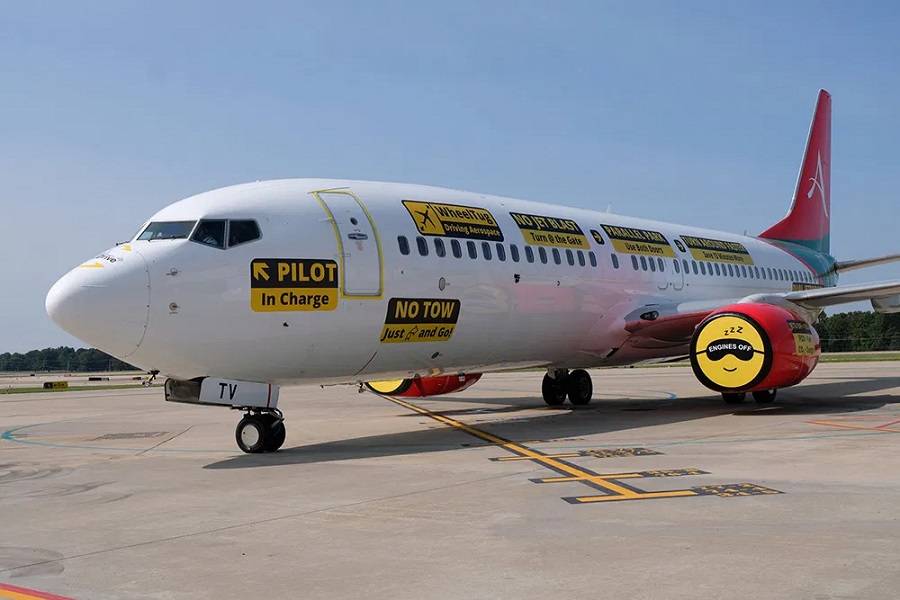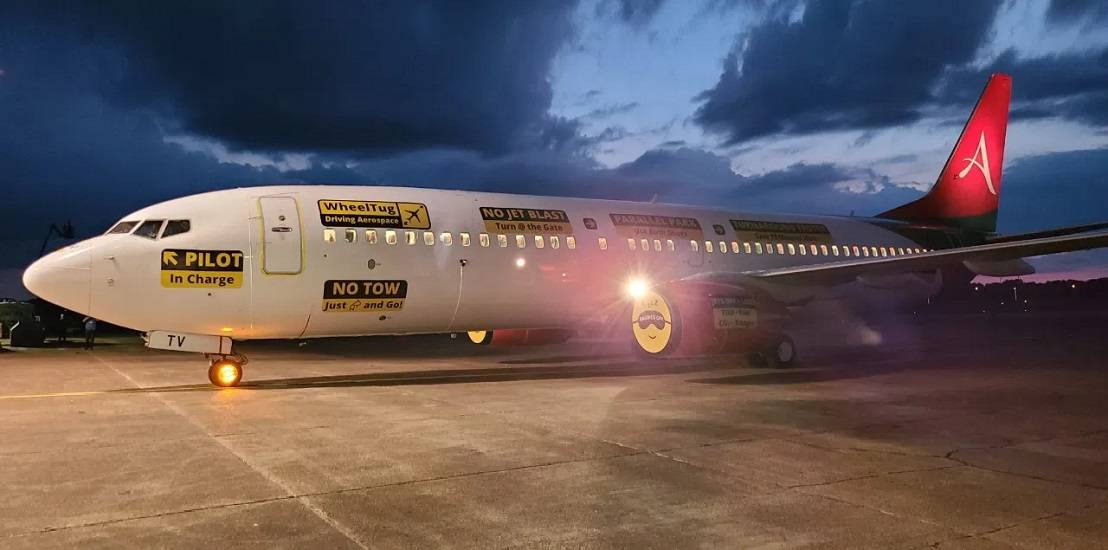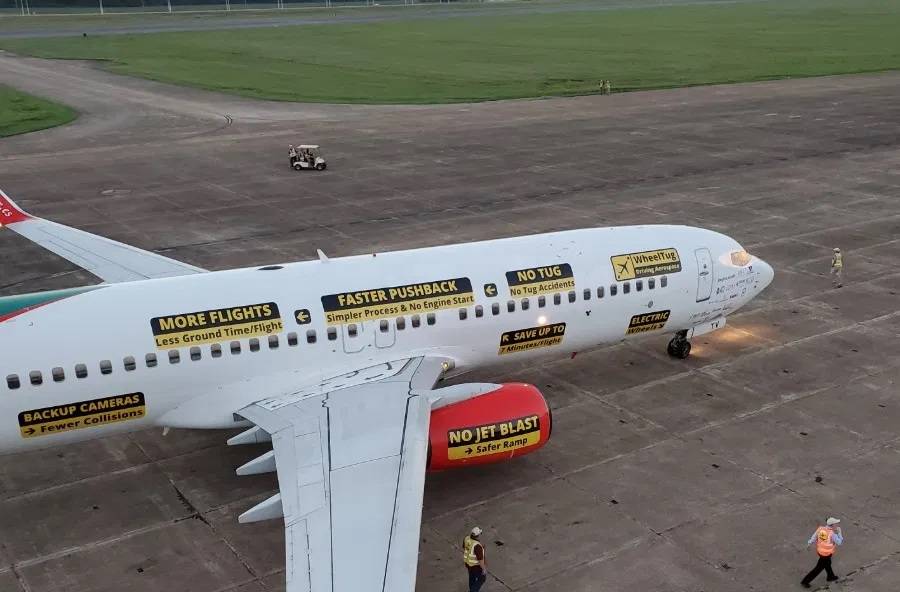After demonstrating its system for the first time last September, WheelTug is now getting more and more orders, from intrigued airlines. The system could potentially reduce emissions and save fuel – and time! Certification could come by the end of the year.
WheelTug’s concept is quite simple. They are fitting two electric motors, inside the nosewheels of aircraft like the 737 and A320. These are high-torque motors, that can handle the weight of a full-laden single-aisle jet. But they don’t use batteries to run. Instead, the motors run on power from the Auxiliary Power Unit (APU), or possibly an idling engine.

While batteries could become part of the system later, not having them has some advantages. Firstly, it makes certification a lot easier. Lithium-Ion batteries, in particular, are something that airlines and aviation authorities are careful with. This will change, eventually. But for now, WheelTug’s system is all about the motors. And a few cameras! Secondly, batteries are heavy. As it is, the only weight the system adds, is the two motors in the nosegear.
The Implications Of Using The WheelTug
Pushback tugs are costly. Airlines often need to pay up to $100 per minute, for the privilege of being driven slowly backwards. And in case you haven’t noticed, pushback tugs need to push planes a long way off the gate – around 100 metres or more. This is to ensure that they are safely away from any structures, before firing up their engines and maneuvering.
But what if planes could self-propel backwards AND FORWARDS, without worrying about jet-blast? That question makes WheelTug especially intriguing. And it gives aircraft and pilots some options that could literally transform airport operations. And the best part? The only real change that the WheelTug system would require at airports, would be to draw some new lines on the ground! OK not exactly – more changes will help fully optimize operations, but it can work fine with airports ‘as-is’.

So airlines can save money, by not needing tugs to get out of a gate. They can also save time. In busy airports pushback tugs can sometimes be in short supply, with pilots often having to wait their turn. But the WheelTug will also allow a couple of maneuvers that wouldn’t be possible, or practical, even with a tug. The company calls them ‘Twirl’, and ‘Twist’.
Normally, a pushback tug will first move an aircraft backwards for a long distance, depending on the airport and stand. It will then turn the plane in the desired direction, and stop. Again, the reason for this long pushback distance is separation from any structures. Usually that’s the terminal, but also any vehicles, carts, rolling air-stairs etc. The WheelTug’s ‘Twirl’ changes that.
Twirling A 737 (or A320)
With a ‘Twirl’ maneuver, the aircraft would first backup a very short distance from the gate. It could do so with ground crew observing the surroundings, or the pilot could have cameras to help him/her. The WheelTug incorporates cameras on the nosewheel, looking both forward and back. Then after backing away enough to be clear of obstacles, the pilot turns the nosewheel to 90°. And then the aircraft does an about-face (or a Twirl, you could say) and continues taxiing, facing forward. The engines stay off, until the plane is well clear.

There is also the ‘Twist’ maneuver. Here, the aircraft taxies head-on into a (bigger) gate, but a few metres left-of-centre, using the WheelTug. Then it stops and makes a sharp right turn, stopping with its left side facing the terminal. Think of it as parallel parking to the gate. This allows two jet-bridges to connect to the aircraft! Of course this assumes that the airport has gates with twin jet-bridges.
WheelTug claims that in some parts of the world, many airports have such gates. This would speed up boarding and deplaning, making for super-quick turnarounds. In any case, if ‘Twirl’ doesn’t work, ‘Twist’ speeds up matters as well. Incidentally, these maneuver names probably won’t become official. They sound too similar to each other. So for clear radio communications, airlines and ATC will likely choose other, more simple (and more boring) names.
WheelTug And De-icing Stands
Another possible use for the WheelTug could be for greater flexibility during winter operations. Right now, aircraft often start up and then need to taxi to a remote de-icing stand. Then they need to shut down their engines, for de-icing to commence. In some airports, it could be possible to taxi from the gate to the de-icing stand using the electric motors, on APU power only. Then once the process is over, they could start normally, and be on their way.

But this won’t be practical everywhere. In their current iteration, the WheelTug can taxi at a maximum 8 miles per hour. If de-icing is a long way from parking, this might be a bit slow. However even then, the system can come in handy, saving a lot of fuel. If there is a queue of aircraft waiting their turn for de-icing, a crew could shut down the engines when they arrive in the back of the queue. Then they can slowly inch forward, as each plane finishes ahead. So instead of waiting for 10+ minutes with one or two engines on idle, they can be on APU only!
To fit the WheelTug system to an aircraft, the company says that two nights are enough. And, the aircraft can do revenue flights, in between nights. So for many operators, it should be possible to fit the system without any out-of-service revenue loss. And crucially, no significant alterations are necessary. Further maintenance for the system can take place in existing service intervals.
Testing, Demonstrator and Orders
Pilot training for the WheelTug is also simple; just computer-based. The AlbaStar pilot demonstrating the system reportedly said that only the nosewheel camera takes some getting used to. The demonstrations took place in a live airport environment, in Memphis. The aircraft is a suitably-adorned Boeing 737-800. The company hopes to have the FAA Supplementary Type Certificate (STC) for the 737NG by the end of the year. The A320 will be next, taking a bit longer.

Interest from the airlines has been quite strong. According to the company, 25 airlines have reserved slots for over 2000 aircraft, for WheelTug systems. Most recently, SpiceJet in India booked 400 production slots. The airline is a 737NG operator. As a low-cost carrier, reducing both fuel consumption and turnaround time, will be vital!
Again, it might take some time for airports to fully optimize their operations, for them and the airlines to take full advantage of the system. But even with current infrastructure, the WheelTug works fine.

The system is an interesting development. We regularly discuss efficiency and fuel savings in flight, but we forget how much time airliners spend, just sitting idle, burning fuel. Substituting the operation of an APU for the two CFM56s, will save tons of fuel per aircraft, per year. For airlines with fleets in the hundreds of aircraft, the savings, in fuel, emissions and time, could be game-changing!
And finally… just a quick thought: what if a pilot turns the wrong way on a taxiway? Facing 4-5 other aircraft, with no taxiway in between them?




5 comments
David Liddle
Weight is not a big factor, it weighs about 300 to 400 lbs – not much more than One passenger plus their luggage. And that would be partly, if not completely offset by having to carry less fuel, which is heavy, as the plane would need less fuel to taxi out to the runway for takeoff and less fuel to taxi from landing to terminal. After landing the pilot can shut off engines and taxi in to terminal using the WheelTug!
Eli Rosenberg-Suzuki (MC)
I love the idea. I hope all airlines buy it, and it could literally save MILLIONS to BILLIONS a year.
DAVID D
So who will be responsible for a fenderbender since the pilot will be busy preping the plane for flight when another one comes up unexpectedly while he or his copilot is backing up.
Christopher Martin
If only Bruce Forsyth were still alive, he could be hired to use one of his catchphrases “give us a twirl”
Natraj Dakshinamurthy
Good idea and sounds great! But what’s the weight of each motor, though batteries are avoided bu drawing power from the apu, it’s almost like doing away with the push back tugs. Since these motors are fitted to the nose wheels, whats the increase in weight and will the nose become heavier and will it cause a similar situation like in the past max8!!!